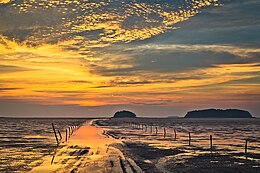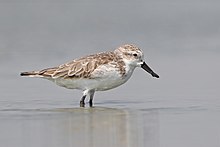Getbol, Korean Tidal Flats
| UNESCO World Heritage Site | |
|---|---|
 Gochang Getbol | |
| Location | North Jeolla, South Chungcheong, South Jeolla, South Korea |
| Criteria | Natural: (x) |
| Reference | 1591 |
| Inscription | 2001 (25th Session) |
Getbol (Korean: 갯벌) are mudflats, or tidal flats, coastal sedimentary systems. They are important habitats for different types of organisms, including migrating birds and marine fauna such as clams, crabs, octopuses, and snails. In 2021, four getbol sites in South Korea were listed as a UNESCO World Heritage Site due to their outstanding natural properties. Each of these sites represent a different type of getbol (estuarine type, open embayed type, archipelago type, and semi-enclosed type).[1]
Description
The four getbol sites that are listed are the Seocheon Getbol, Gochang Getbol, Shinan Getbol and Boseong-Suncheon Getbol. Three sites are located on Korea's western coast while the Boseong-Suncheon Getbol is located on the southern coast.
The tidal flats developed after the

Threats
All four sites are strictly managed as Wetland Protected Area (WPA) under the Wetlands Conservation Act. Still, there are some risks that are posed to the environment by activities such as dredging of port and sea lanes, construction of land-to-island and island-to-island bridges, development of offshore wind-power generation, mining of marine aggregates, introduction of harmful or marine ecosystem disturbing species, and fishing activities of locals. The most detrimental activity is land reclamation, but such actions are strictly banned in the World Heritage Sites.[2] Possible environmental pressures include marine and coastal pollution, climate change, coastal erosion, and oil spills.[2]
References
- ^ a b c "Getbol, Korean Tidal Flats". UNESCO World Heritage Centre. Archived from the original on 5 July 2020. Retrieved 9 July 2022.
- ^ a b c d e f "Getbol, Korean Tidal Flat, For Inscription on the World Heritage List". Cultural Heritage Administration, the Republic of Korea. Retrieved 7 September 2022.
- ^ "UNESCO World Heritage Centre The Criteria for Selection". UNESCO World Heritage Centre. Archived from the original on 12 June 2016. Retrieved 17 August 2018.
Further reading
- Getbol, the Korean tidal flats and sustainable seafood dining by The Korea Herald
- Korean tidal flats to join UNESCO Natural World Heritage list by The Korea Times
External links
- Official Website (in Korean)
- Getbol, Korean Tidal Flats UNESCO Collection on Google Arts and Culture
